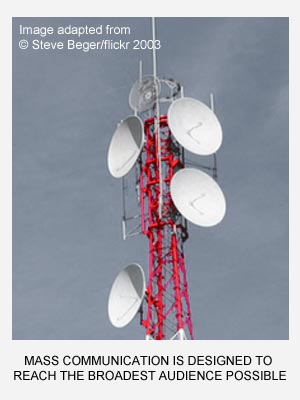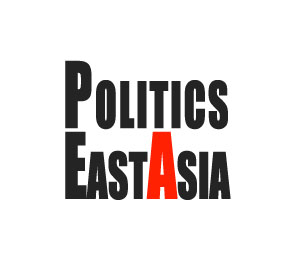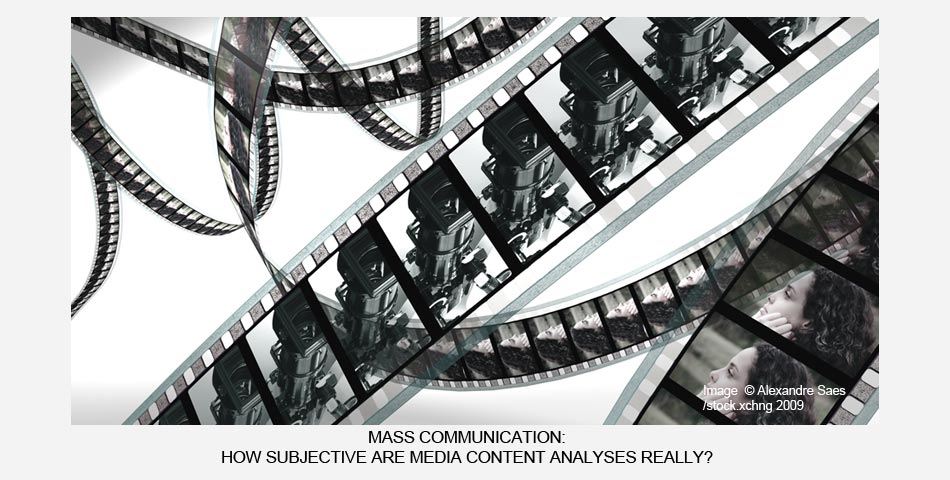Studying the Patterns of Mass Communication
Why media content still matters
I recently had a fascinating conversation with my colleague Kong Shuyu from Simon Fraser University, who analyzes how audiences in China receive and make use of cultural products, such as blockbuster films. We talked about the huge success that James Cameron’s movie Avatar had in the PRC, and how this popularity was not solely grounded in the impressive special effects, the novelty of 3D cinema, or the international hype surrounding that particular film. As censors in China had feared at the time, and as Kong is now confirming through ethnographic methods like qualitative interviews, the movie’s theme reminded audiences in China of their own social woes. Many viewers interpreted the film as a story of an inhumane capitalist modernity that disenfranchises those who are most vulnerable. For those who had become victims of forced evictions for the sake of urban development, there was a clear analogy to the fate of the native inhabitants of the planet Pandora, who lost their tree-home to an evil interstellar mining conglomerate. In China, Avatar became a political issue.
To me, this is a fascinating case, and one that makes me look forward to reading Kong’s book on the subject once it is finished. It also raises a broader question for me, however, particularly since I would not have interpreted Avatar in the way that many Chinese viewers apparently did. I always thought Cameron’s film was a somewhat poor analogy to the fate of Native Americans, mixed with simplistic fad du-jour environmentalism, and overloaded with special effects to distract audiences from the sound of the US cultural industries stealing their money. I particularly felt offended by the fact that the naive noble savages end up finding a saviour in the white man, and so this movie review pretty much summed the film up for me.
As someone who analyses visual political communication by looking at production backgrounds and at content, while largely side-stepping questions about audience reception, this discrepancy between interpretations at first seems to pose a challenge. Is this example not evidence that meanings are subjective, that audiences will interpret content as they see fit, and that research on political discourse and how it gets produced is a dead end?
In light of these questions, I want to revisit what an analysis of mass-communication content can achieve. In this post, I first discuss why our seemingly subjective interpretations of messages do not need to prevent us from systematically analysing those messages. I’ll share some of my views on the general characteristics of communication, before discussing what makes mass-communication “massive”. I’ll conclude with some thoughts on why content analyses and reception analyses might not be mutually exclusive enterprises.
The art of communicating
Communication between humans is an incredibly complex process. Just imagine what is required on your part if you want to explain to a stranger why you are interested in the politics of East Asia. In order to get your idea across, you have to draw from cultural resources at your disposal to compose a message while carefully judging what background knowledge you can assume on the part of your conversation partner. You then need to get your message across in a specific language, deploying words, body-language, and inflection to assure that your message reaches the intended audience. What is more, most of this process isn’t even under your conscious control, and yet you have to make sure that your conversation partner indeed understands your message the way it was intended. If you are engaged in a dialog, then the other person will have to formulate a response, which you will then need to unpack and interpret, and so on. Imagine how complex all of this gets when you involve additional people, not to mention what happens if some of the actors are joking or are being deceitful.
Yet we rarely come out of a conversation wondering what our communication partners were saying. Miscommunication happens, of course, but it seems to be the exception rather than the norm. That is because human beings evolved to be animals that communicate exceptionally well. In most circumstances, it costs us hardly any effort to communicate our ideas, and we can generally trust ourselves to get the job done without producing too many misunderstandings.
Our ability to exchange ideas is one of the amazing adaptive qualities that helped our distant ancestors survive long enough to produce our slightly less distant ancestors. It is an ability closely linked to our capacity for complex thought. As Paul Chilton (2004: 18) puts it, “if you can simulate the outer world by inner worlds, you are an animal with an advantage, because you can map places, objects and predators, and you can make plans for future actions”. The ability to then share such thoughts has very useful applications. For instance, we can tell our partners and our offspring to mind the woods nearby, since that is where blood-thirsty sabre-toothed tigers are roaming about. It also has the advantage of allowing us to cooperate with other humans, for instance to build a wall that will keep sabre-tooths out of our village all together, or to coordinate our next hunt for woolly mammoths.
There is of course far more to the debate of how language co-evolved with human social and communal behaviour than I have suggested above. If you are interested in these processes, Paul Chilton has provided an excellent nuanced discussion (2004: ch.2). My point here is that communication is of fundamental importance for organizing social actions. It is essential for politics. Small wonder, then, that human communication is generally highly effective, and that the way we communicate is consequently far from arbitrary.
What’s in a message?
Communication follows certain rules and conventions. For instance, we can reasonably assume that the people we speak to are going to try and understand what we have to say, and that they in turn will try to tell us what they have to say in a manner that is accessible to us. If this weren’t so, we would have serious problems understanding each other. In fact, it is precisely because we make such assumptions on a regular basis that it becomes possible to lie or cheat. However, even such deceptions follow patterns: when I lie, I need to manipulate my deceitful message in a way that gets enough truth across to be believable while hiding or obscuring the parts that are false – all the while using conversation conventions that make my statement comprehensible. Other highly creative forms of communication similarly follow patterns that are not at all arbitrary, as demonstrated by research into the use of metaphors (Lakoff & Johnson 1980), analogies (Fauconnier & Turner 2002), proverbs (Dörner & Detje 2001), or humour (Morreall 2009).
This is not to say that meanings somehow exist in an objective, disembodied realm (cf. Lakoff & Johnson 1980: 226-228): Meanings are highly contextual, and they shift not only over time but also between cultural settings. But what is important to remember is that the process of understanding is grounded in mechanisms that are open to analysis.
An approach to communication mechanisms that I have found very useful is the theory of semiotics, which views communication as a compilation of signs that point to certain meanings. I have discussed this theory in more detail in another post, but one aspect of semiotics that is worth mentioning here is that communication works through codes.
The little bits and pieces that make up meaningful messages do not float about randomly. They are part of larger systems of meaning, which each have their own logic, and this logic is called a “code”. For example, if economists come together and discuss growth rates, and interest rates, and capital accumulation, and total factor productivity, then these concepts may not mean much to the uninitiated, but they make sense to the economists because such key terms are linked together in an overarching framework of knowledge. They are part of an economics discourse. If we know what each of these words stands for, and how they are related, then we can understand what the economists are talking about. Similarly, a discussion about Chinese politics might revolve around phrases like “harmony”, “masses”, “three represents”, “three closes”, and other seemingly ambiguous terms, but once we place these terms in the context of CCP ideology, we are in a position to make sense of how they are used.
In short, communication processes are informed by systems of meanings called discourse, and are governed by rules called codes. These codes reflect social and cultural conventions. Yet even though certain codes may appear incomprehensible to outsiders, for instance when an adult is confronted with the seemingly nonsensical jargon of youth groups, there is nothing mysterious about them. Once we learn the codes, and learn when to apply them, we can “decode” communication that takes place within a specific framework of meanings. That is why it is so important to keep the context of a communication process in mind: the plot of Avatar, for instance, may receive radically different meanings when understood through the lens of American history than when it is understood through the lens of contemporary Chinese social problems. In either case, however, I would hesitate to call such interpretations “subjective”, since they follow patterns that can become the object of empirical analysis.
Putting the “mass” into mass communication
If everyday communication is generally comprehensible, and thus lends itself to analysis, then the same can be said of mass communication. In fact, mass communication is an even better object of content analysis. That is because mass communication aims to reach a broad audience. It intentionally and systematically narrows down the meanings of its messages even more than other forms of communication.
What, then, makes mass communication “massive”?
The philosopher and art theorist Noël Carroll (1998) has provided a useful answer to this question. Even though Carroll is primarily interested in a sub-set off mass communication that he calls “mass art”, which includes narrative entertainment in the form of films, TV series, best-seller novels, and so on, his arguments are also useful for understanding mass communication in general. For Carroll, mass art is fundamentally different from avant-garde art, since it tries to be accessible. Works of so-called “high” art, like Beethoven’s Fifth Symphony, or James Joyce’s novel Finnegan’s Wake, or Picasso’s painting Guernica, are all intentionally ambiguous and do not possess one “correct” interpretation. Engaging with their many hidden potentials, their fragmented and complex meanings, and the feelings they illicit in each of us, is a highly rewarding challenge. That is what makes these works interesting and enjoyable. Mass art, according to Carroll, is a different kind of art – though by no means one that is less worthy of our attention.
This is Carroll’s definition of mass art (1998: 196): “X is a mass artwork if and only if 1. X is a multiple instance or type artwork, 2. produced and distributed by a mass technology, 3. which artwork is intentionally designed to gravitate in its structural choices (for example, its narrative forms, symbolism, intended affect, and even its content) towards those choices that promise accessibility with minimum effort, virtually on first contact, for the largest number of untutored (or relatively untutored) audiences.”
 There is more in this definition that is worth unpacking and discussing than I have space for here, and I can only urge you to take a closer look at Carroll’s discussion of the “nature of mass art” (1998: ch.3). Several aspects of Carroll’s philosophy are no doubt controversial. For instance, it may indeed be useful to accept only cultural products as “mass art” that exist as many identical copies, delivered to different recipients by means of information and communication technologies like DVDs, TV broadcasts, or mp3s. However, this means that various kinds of performances would not count as mass art, for instance a theme park like Disneyland, or live musicals and pop concerts (unless they are recorded or broadcasted).
There is more in this definition that is worth unpacking and discussing than I have space for here, and I can only urge you to take a closer look at Carroll’s discussion of the “nature of mass art” (1998: ch.3). Several aspects of Carroll’s philosophy are no doubt controversial. For instance, it may indeed be useful to accept only cultural products as “mass art” that exist as many identical copies, delivered to different recipients by means of information and communication technologies like DVDs, TV broadcasts, or mp3s. However, this means that various kinds of performances would not count as mass art, for instance a theme park like Disneyland, or live musicals and pop concerts (unless they are recorded or broadcasted).
I myself would include these examples under the header of “mass communication”, since I find it important that they communicate to a broad audience, and that they disambiguate their messages by systematically deploying certain communication conventions. In other words, when it comes to mass communication, I am most interested in the third point of Carroll’s definition: that the messages are intentionally designed to be comprehensible by a large audience, and that the communication process consequently makes use of structural features that radically reduce ambiguities. To me, mass delivery is a common consequence of this rationale, but not a necessary prerequisite. If someone writes a screenplay for a blockbuster that is never produced, does that make the screenplay any less of an attempt at mass communication? What matters to me is that mass communication makes specific structural choices. As Carroll himself writes in his discussion of music television, these choices often exploit our innate perceptual “hard-wiring” in order to capture our attention, elicit emotional responses, appeal to recognizable narrative templates, and generally be accessible (ibid.: 203).
All of these characteristics of mass communication lend themselves to systematic content analysis. If you are interested in analysing the political content of a Manga, or a Chinese blockbuster, or a Korean soap opera, or a Taiwanese news broadcast, then you are already equipped with the necessary tools: your human perception and thought. I’ll have a post ready in July with practical tips and tricks on how to conduct an analysis of such mass media content, but what is worth taking away from this discussion here is the following: If you take the cultural and historical context of a mass-communicated message seriously and familiarize yourself with the conventions of the medium and the genre, then you are in an excellent position to “decode” that message in a professional, empirical way.
Why we need production, content, and reception analyses
To Carroll, the fact that mass art is designed to be generally accessible makes audience reception analyses such as sociological polling largely redundant (ibid.: 271). Carroll argues that since mass art deploys recurring structural patterns with the explicit intention of reaching the largest possible audience, we can treat ourselves as a barometer for the meanings of mass-mediated content. After all, we are also part of the mass audience. Maybe more importantly: everything needed to decode a mass-communicated message is already present in the message itself.
Carroll has a point, but I myself do not think that the nature of mass communication makes sociological, psychological, or ethnographic research of media receptions meaningless. In fact, I think that such analyses are highly valuable because they explore dimensions of mass communication that content and production analyses do not deal with. They ask different questions, and offer different angles on the same complex topic. These different approaches are sides of the same coin, and are by no means mutually exclusive.
Particularly when it comes to the question of how political discourse gets constructed and relayed, sociology and anthropology offer tools that are very valuable. The case of Avatar’s relevance in China is an excellent example. It demonstrates how specific social groups draw from cultural resources to create discourse, set political agendas, and frame discussions. One of the great challenges in an age of information is to trace how this happens. I, for one, am grateful for any interdisciplinary approach that contributes to our understanding of how these complex communication processes work.
References
Carroll, Noel (1998). A Philosophy of Mass Art. Oxford: Oxford University Press.
Chilton, Paul (2004). Analyzing Political Discourse – Theory and Practice. London: Arnold.
Dörner, Dietrich & Detje, Frank (2001): “Denksprüche und Sprichwörter des Planens (The Epigrams and Proverbs of Planning)”, in Strohschneider, Stefan & von der Weth, Rüdiger (eds.): Ja, mach nur einen Plan: Pannen und Fehlschläge – Ursachen, Beispiele, Lösungen (Sure, Go Ahead and Plan: Mishaps and Failures – Causes, Examples, Solutions). Bern et al.: Hans Huber: 255-271.
Fauconnier, Gilles & Turner, Mark (2002). The Way We Think: Conceptual Blending and the Mind’s Hidden Complexity. New York: Basic Books.
Lakoff, George & Johnson, Mark (1980). Metaphors We Live By. Chicago: The University of Chicago Press.
Morreall, John (2009). Comic Relief – A Comprehensive Philosophy of Humor. Malden & Oxford: Wiley-Blackwell.
Share This Post, Choose Your Platform!
2 Comments
Comments are closed.



[…] discourse is not expressed through language, but through gestures, images, or sounds? What happens when discourse becomes mass-communicated? This is where another approach to communication provides helpful answers: the theory of […]
[…] have argued in another post that communication is a fundamental human process that works according to general mechanisms that we can explore systematically. If you generally […]